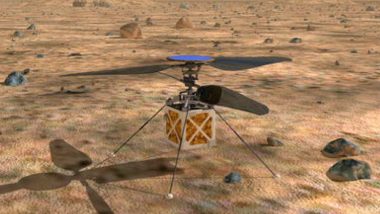The National Aeronautics and Space Administration (NASA) is sending a helicopter to Mars. Yes, when the administration launches its next rover to the red planet; it will have a small helicopter along for the ride. On May 11 NASA announced that they will send a small autonomous flying chopper, suitably calls it— Marscopter with the upcoming Mars 2020 rover which is scheduled to launch in July 2020. The tiny helicopter will test the capabilities for controlled flight in the thin atmosphere of Mars and is also expected to pave the way for future uses across the solar system.
They further informed that it took 4 years for the team to design, test and redesign the Marscopter that weighs in at little under four pounds (1.8 kilograms). NASA Administrator Jim Bridenstine said, “The idea of a helicopter flying the skies of another planet is thrilling. The Mars Helicopter holds much promise for our future science, discovery, and exploration missions to Mars.” After the rover lands on Mars in 2021, NASA will use the spacecraft’s cameras to scan the ground of the planet, find a suitable flat place to set the tiny helicopter down.
Once the marscopter is settled, the scientist will command to take off. After that the helicopter will be on its own; flying independently. “We don’t have a pilot and Earth will be several light-minutes away, so there is no way to joystick this mission in real time,” said Mimi Aung, the Mars Helicopter project manager at Jet Propulsion Laboratory (JPL) in the statement. If launches successfully, this body will become the first in history to fly as the first heavier-than-air craft on another world.
Check the video of the Marscopter!
We’re sending a helicopter to Mars! Traveling onboard our #Mars2020 rover, this #Marscopter will test our capabilities for controlled flight in the thin atmosphere of the Red Planet and could pave the way for future uses across the solar system: https://t.co/uZFyRmUTgh pic.twitter.com/XlCP9xERub
— NASA (@NASA) May 11, 2018
NASA will test the drone for 30 days to see how it performs in an environment unlike Earth. The atmosphere at Mars is very thin; about 1 percent of Earth’s. Hence flying in a low air density is a challenge. As a technology demonstration, the Mars Helicopter is considered a high-risk and a high-reward project. If it does not work, the Mars 2020 mission will not be impacted. If it does work, helicopters may have a real future as low-flying scouts and aerial vehicles to access locations not reachable by ground travel.
“The ability to see clearly what lies beyond the next hill is crucial for future explorers,” said Thomas Zurbuchen, Associate Administrator for NASA's Science Mission Directorate at the agency headquarters in Washington. He further added, “We already have great views of Mars from the surface as well as from orbit. With the added dimension of a bird’s-eye view from a ‘marscopter,’ we can only imagine what future missions will achieve.”
Mars 2020 will be launched on a United Launch Alliance (ULA) Atlas V rocket from Space Launch Complex 41 at Cape Canaveral Air Force Station in Florida and is expected to reach Mars in February 2021. This is an exciting experiment and will definitely inspire individuals to become scientists and make greater discoveries in the future.
(The above story first appeared on LatestLY on May 12, 2018 03:02 PM IST. For more news and updates on politics, world, sports, entertainment and lifestyle, log on to our website latestly.com).













 Quickly
Quickly


